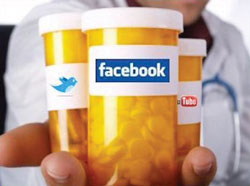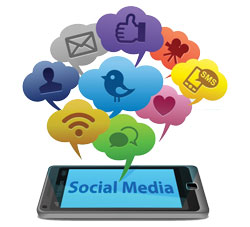Since 2005 the number of adults that use social media in the United States has risen from eight percent to 72 percent, according to Forbes.com. Social media use is on the rise, and though many may not realize it, frequent use can be seen as an addiction.
“I find myself clicking on my Facebook, Twitter and Instagram icons over and over, as if my newsfeeds are going to change and show me something incredibly different within seconds,” said Kelly Brockett, senior communication major. “I find myself more worried about what’s going on in the social media world rather than taking in what is physically around me, a bad habit I am trying to break.”
Use of social media has become very common among people. People are found using cell phones while in supermarkets, hallways, dinners and even in classrooms. A cell phone can be found in a student’s hands, pocket and even on top of their desk.
“When I am walking I use it to play music, text or for social media. I always have my phone on me, also if I can get away with having it on my desk then it’s usually there,” said Marcus McKenzie, Penn State University senior. “I check Twitter and Instagram every moment I get.”
George Kapalka, Chair of the Department of Psychological Counseling said he thinks the phone is a tool. “I think what people are attached to and crave is more what the activity is and the phone simply provides them an easy way to be able to do that,” said Kapalka.
Kapalka continued, “People now seem to crave being connected with the social media and that really has replaced social groups to a large extent.”
Craving social media is what is seen as an issue. The use of social media is one thing, although once feelings of distress and unpleasantness occur because a person is unable to access their accounts as a serious issue may be at hand.
A psychological fear has been diagnosed called “nomophobia” or no-mobile-phone-phobia, it is the feeling that people experience when their phone was left at home, dies or they are unable to access it, according to nomophobia.com. The fear causes high levels of stress that is created when unable to communicate through the cell phone at any time of the day. Some of the reasons people experience this fear is due to losing or forgetting their phone, SIM card failure, battery failure, running out of minutes, traveling, or from poor reception.
“I am guilty of experiencing a complete sense of panic when I leave my phone at home. I just feel completely disconnected and almost vulnerable,” said Kayla Horvath, communication major.
 Boost Mobile conducted a survey of 500 males and females between the ages of 16-25 years living in Australia. Almost half of the surveyed group admitted to being addicted to social media, and 68 percent who confessed checking their social media feed 10 times a day.
Boost Mobile conducted a survey of 500 males and females between the ages of 16-25 years living in Australia. Almost half of the surveyed group admitted to being addicted to social media, and 68 percent who confessed checking their social media feed 10 times a day.
A Fox Business report found that Americans spend on average of 16 minutes every hour on social networking sites. The report stated, “Your intention might be to hop online to quickly update your status or tweet your latest life revelation, but social media is addictive and a major time consumer.”
The need to check a cell phone has become so common and even natural to people that the Huffington Post name the reaction a mechanical movement. “…You can’t help yourself, because checking your smartphone is a mechanical movement for you, as involuntary as breathing or blinking or producing saliva in your mouth.”
Brocket explains that when she does not have her phone she feels “sheer panic.” “I feel like my life is on that phone, all my contacts, my calendar, my email, everything … I’d be too worried I was missing someone trying to get a hold of me if I didn’t have my phone.”
Many have found that if they don’t check their phone or go a period of time without scrolling through non-existent notifications, they begin to feel a vibration that never actually happened. This feeling has been named, “phantom vibration syndrome.” The syndrome is a perceived vibration from a device that is not actually vibrating, according to a study done by Indiana and Purdue University’s Department of Psychology.
The study found that 89 percent of the 290 undergraduate students experienced phantom vibrations. The students in the study explained that they experienced phantom vibration syndrome about once every two weeks on average. The study also found that the students who expressed a strong reaction to a vibration or phone notification, experienced phantom vibration syndrome more often.
Many wonder what is so appealing about social media. “I think people are becoming so addicted to social media because it fulfills a certain drive or need that we never before had the means to like we do now, nosiness,” said Horvath. “Almost everyone likes to feel connected and is curious about what the big news is in their friends or families life.”
Horvath adds that social media is a mindless activity that is very easy to look at. “I use social media multiple times a day. Most of the time it is simply because I am bored and curious as to what else is going on around me.”
“I use Instagram the most. It’s just so dumb. I sit there and refresh, refresh, refresh the page. I know I’m better than that. I can be doing things that are actually worth whole with my time but no,” Raven Brunson senior communication major said.
Social media is an activity that is used by people almost every day but what uses are considered as an addiction? “I think that addiction to social media is when you are constantly on it. If you pick it up while in the middle of conversation with someone you’re not listening,” said Brunson.
Horvath said, “I think a person could be considered addicted when they post multiple tweets, Facebook posts, or Instagram posts per day.”
Brockett explains that social media addiction is, “people who are sometimes far too interested in what their newsfeeds look like instead of being mentally present while they are spending quality time with friends and family.”
To some, exhaustive amount of social media use is not seen as an addiction. “Addiction is a pretty heavy word that shouldn’t be thrown around too lightly,” said Jen Pacheco, senior psychology major. “People get addicted to heroin. But it’s not crazy to think that our impulse to constantly check social media time after time and scroll, scroll, scroll is detrimental to us in some way.”
Franca Mancini, Director of Counseling and Psychological Services said, “Addiction isn’t normal, and I hesitate to use that term other than in extreme cases, but there is the possibility that for some individuals that habit of the cell can get out of hand.”
Pacheco adds, “It’s becoming a societal norm, you’re weird if you’re not connected.” Based on the amount of social media users it has become “the norm.”
“I do not think people are consciously aware of the addiction because it has just become a part of our life,” said Horvath. “We are over-saturated by it. It is the new norm.”
As a result of increased social media use, people are finding themselves searching for help. In September of 2013 the first inpatient Internet addiction treatment center in the country opened at Bradford Regional Medical Center in Pennsylvania.
Psychologist Dr. Kimberly Young decided to open the center after spending the past 18 years treating patients addicted to the Internet. She felt that the issue was rising and due to the amount of requesting treatment options, something needed to be done.
The center offers a 10-day inpatient program available to adults over 18-years-old. The center currently offers 16 available beds and uses the Cognitive Behavioral Therapy principle, or “talk therapy” to help overcome their addiction through verbal communication.
The internet addictions vary from social media, eBay, pornography, and gambling addictions. The patients experience a 72-hour detox from the internet where they are slowly reintroduced to face-to-face communication.
“Is this a start of a new revelation?” said Andrea Gonzalez, political science major. “A revelation as in, do people really not know how to resist using social media? I am shocked to hear this but I fear that it will only lead to more addiction centers throughout the control.”
Many wonder how this continued use of social media may affect people and relationships in the future. Kapala explains that the relationships are not as personal as they were before. “I don’t want to be fatalistic, but I am not particularly optimistic of the effect that it is going to have,” he said.
Kapalka continued, “I am concerned that it’s going to turn us as human beings into more and more self-centered people that don’t know too much about empathy and how to express it, because you don’t develop as much close physical relationships … Because the interaction is through social media or over text rather than physically being there watching the person react to what you are doing.”
The first step to addressing the issue is first realizing that increased social media use is a problem and can create lasting effects. Checking a cell phone 10 minutes of every hour is seen as a societal norm, meanwhile others using social media excessively are checking in to internet rehabilitation centers.
“It should not affect your outside experiences. The screen is not your life and it should not be used constantly,” said Brunson. “I’m not Instagram famous, nor do I feel that way. I just think that I over use it.”
IMAGE TAKEN from wompmobile.com
PHOTO TAKEN from diggbuzzme.com



